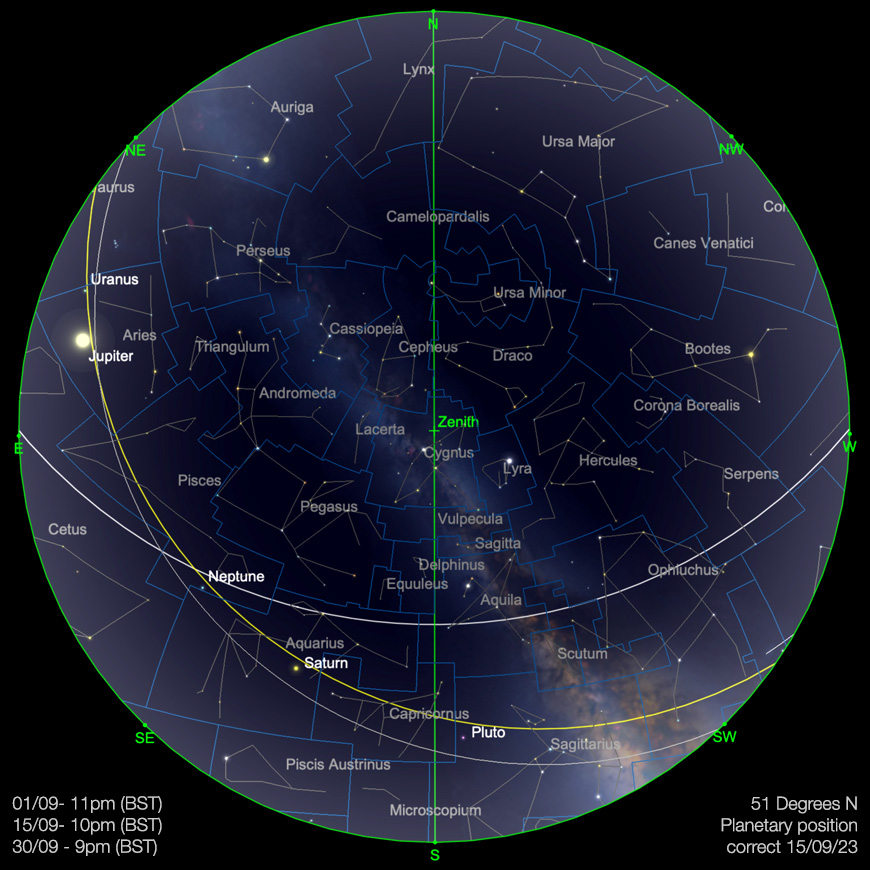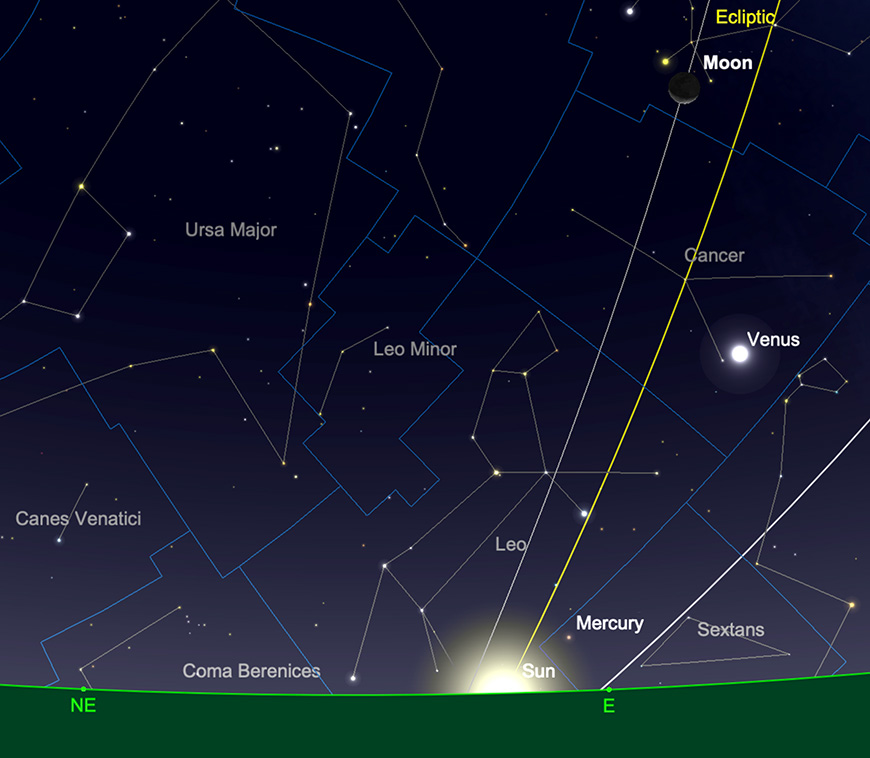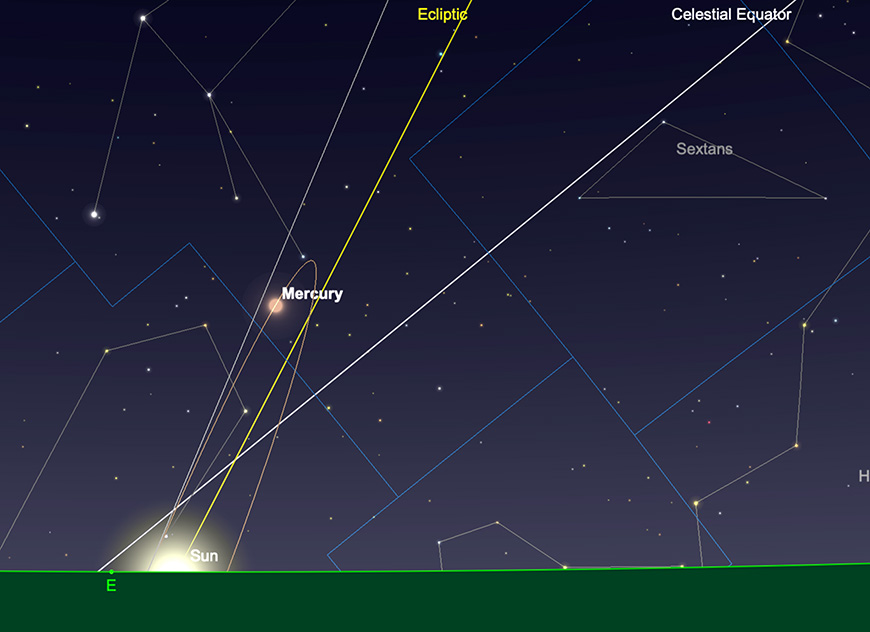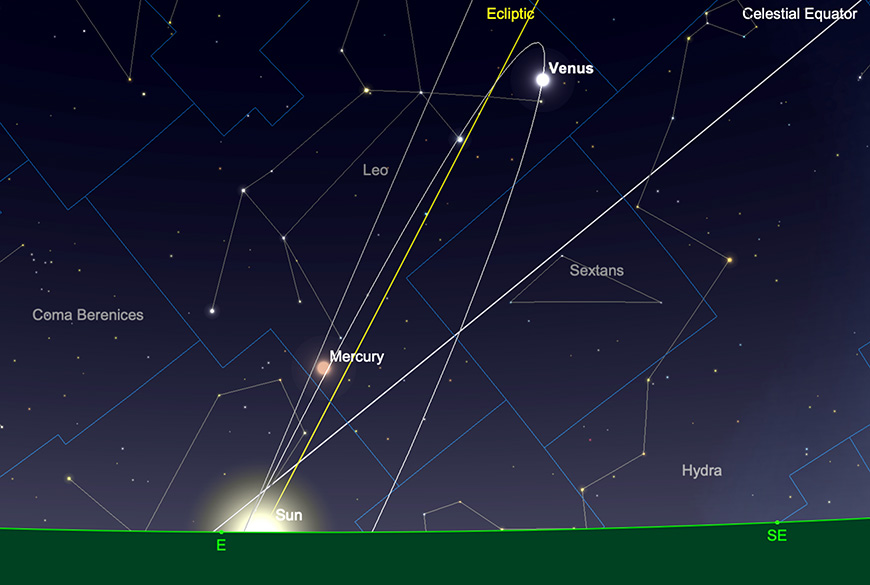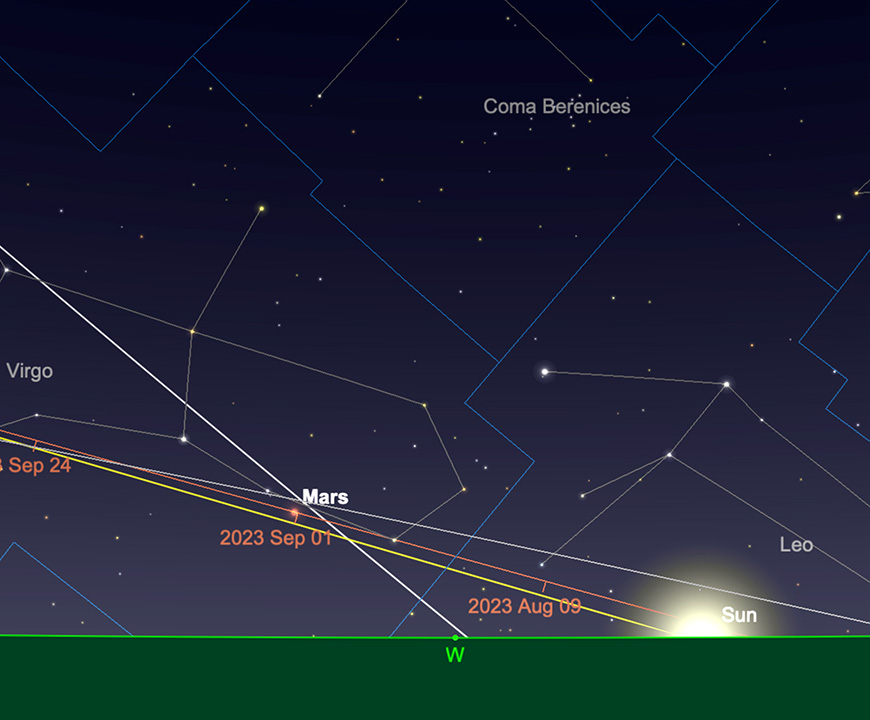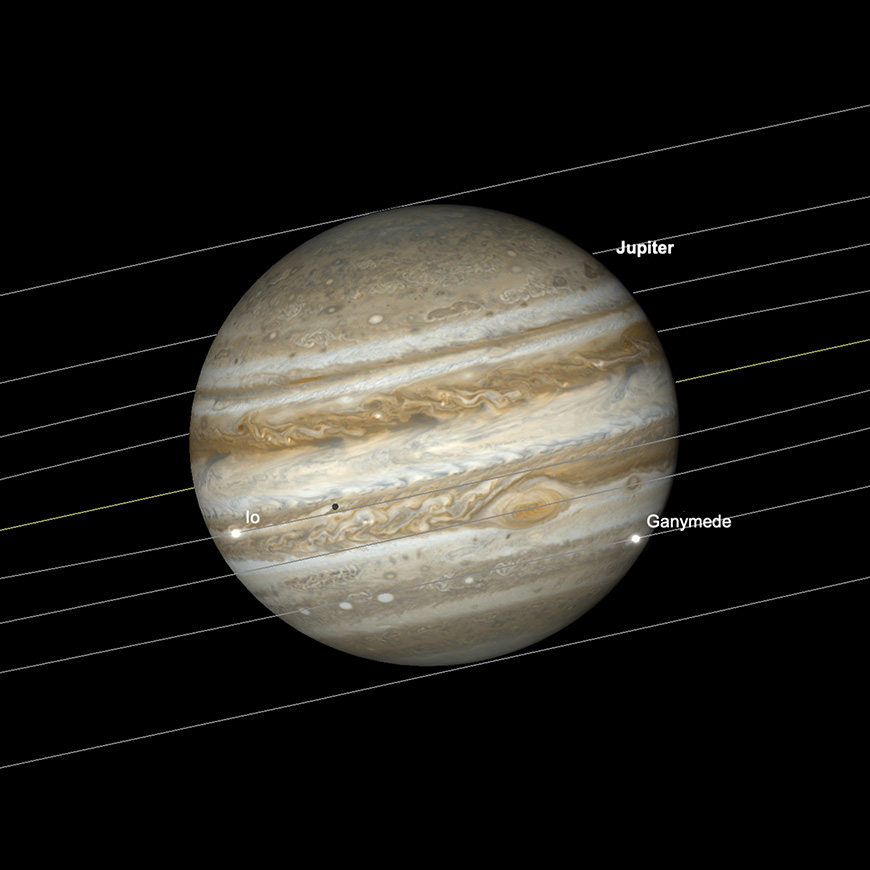Telescope House Hosted by Bresser UK
September 2023 Sky Guide
September heralds the Autumnal Equinox in
the Northern Hemisphere and the Spring Equinox for those in the Southern
Hemisphere. This year, these phenomena take place on September 23rd, a day
when, briefly, day and night approach equal durations. The term “Equinox” has its roots in
Latin, with “Equi” denoting equal and “Nox” meaning
night. However, the true balance of day and night on this date varies based on
one's location; there are limited spots on Earth where the 23rd of September
witnesses a genuine equilibrium. Importantly, September 23rd signifies the
moment the Sun transitions into the southern celestial hemisphere. This leads
to longer nights in the Northern Hemisphere and shorter ones in the Southern
Hemisphere. While many who don’t particularly delve into astronomy might lament the diminishing
daylight in the Northern Hemisphere, enthusiasts who follow this Sky Guide
likely view it differently. For those of us stargazing in the upper Northern
latitudes, the descent into winter brings its own rewards.
As ever, there's a lot to see in skies
above us this month...
The Solar System
The Moon
As August was a month which featured a
so-called Blue Moon (two full Moons in one calendar month), we begin September
with the Moon at just past Full phase. A resident of the zodiacal constellation
of Pisces, the Moon rises on the evening of the 1st at just before 9 pm (BST).
Common sense dictates (though we will mention it anyway) that the beginning and
ending of September will not be the most prime opportunities for observing,
fainter deep sky targets, due to the well-illuminated Moon’s presence throughout the night. The moon
will transit at just past 3 am (BST), the following morning, and will be
flanked to the west by Neptune and Saturn and higher to the east, by Jupiter.
The next couple of days finds the Moon
tracking through Pisces into Aries, where it will have a reasonably close
encounter with Jupiter on the evenings of the fourth and fifth. The following
evening, 6th September, finds the Moon at Last Quarter in Taurus, after which,
the moon will begin to descend towards the Sun, displaying a crescent phase.
This time of year, is analogous to the Moon’s “High Spring
Crescent phases” of springtime. But instead of the Moon appearing high in the
sky at crescent phase in the evenings, at this time of year, due to the acute
rising angle of the ecliptic plane, the Moon’s separation from the horizon in the
northern hemisphere in the morning sky approaches maximum and leads to
extremely favourable conditions for observation.
As the Moon crests over the “top“ of the northern ecliptic, through the constellations
of Gemini and Cancer over the next couple of days, the rapidly diminishing
crescent appears to almost lie “on its back” in relation to the horizon.
This view of the Moon is commonly enough seen from the equatorial and tropical
regions of the planet, where the ecliptic plane tends to run almost right
overhead, but much more of a rarity for those of us resident in higher
latitudes. Ancient cultures often referred
to this view of the Moon as “boat-like“.
The most famous example of this is the Egyptian legend of the sacred moon-boat
of the scribe god Thoth. When the Moon appeared in the sky “on its back”
in crescent phase, it was said that this was Thoth going about his heavenly
perambulations in his boat.
The Moon crosses over the border into Leo
on the morning of the 12th September and can be found almost in line with the
dazzling planet Venus at sunrise. By
this time, the moon will be displaying a 6.9% illuminated crescent phase and
will be progressively more difficult to find in the sky closer to dawn.
The Moon comes to New phase as it joins the
Sun on the Leo/Virgo borders on 15th September. After which it will re-emerge
as an evening target. The minutely illuminated crescent moon will pass the
diminutive Mars in the early evening sky on September 16th. However, this
conjunction will be unlikely to be witnessed by many – if any - observers, due
to the proximity of both bodies to the Sun and the horizon.
The next few days will find the Moon
traversing further eastwards, through the wide expanse of Virgo, into Libra and
Scorpius, until it reaches First Quarter in Sagittarius on the evening of the
22nd. Just as the Moon’s morning crescent phase appears high in
the sky at this time of year for northern hemisphere observers, the evening
crescent phase appears very low in the sky. This relatively poor separation
from the horizon of the evening crescent Moon at this time of year will
naturally have consequences for seeing conditions for those with telescopes.
While always encouraging those with telescopes to make the most of observing
our natural satellite, we advise to keep magnification sensibly low, in order
to preserve the quality of view. The closer an object is to the horizon, the
more one does battle with air currents and truncation of the atmosphere, leading
to poor visibility. And the larger the
aperture of Telescope you have, the more efficiently it will resolve
atmospheric turbulence. When you look at the Moon through a telescope in the
northern hemisphere, at this time of the month, you’ll see what we mean!
The Moon then begins to climb out of the
most southerly part of the ecliptic, passing through Sagittarius, Capricornus
and on into Aquarius, where it will meet Saturn again on the evening of the
26th.
The Moon becomes Full on the
Aquarius/Pisces borders on the 29th and ends the month the next evening on the
Aries/Pisces borders, a little to the west of the very prominent Jupiter.
Mercury
Mercury begins September in a poor position
and unobservable for northern hemisphere observers. The solar system’s smallest true planet is headed sunward
and reaches inferior conjunction on 6th September.
As with anything Mercury-related, we don’t have to wait too long for the situation
to change from the dire, to the very much more favourable. As mercury reemerges from the Sun into the
morning sky from the latter part of the month, it becomes observable and
rapidly brightens. As we mentioned in regards to the Moon in the morning sky,
the area of the ecliptic (Leo) that Mercury finds itself in at present, rises at
a very steep angle for observers in the northern hemisphere. This increases the
separation of Mercury from the horizon, leading to a very favourable morning
apparition. By the time mercury reaches maximum western elongation from the Sun
on September 22, it will stand over 15° high
due east at daybreak (from 51° north).
By this time, the planet will be a visual magnitude of -0.3 and display a 7.2
arc second diameter disc, illuminated by just over 47%.
The next few days sees Mercury climbing in
visual magnitude, as pulls further around its orbit and increases its
illumination, as seen from Earth.
By the time we get to the end of the month
on the morning of the 30th, Mercury will be -1.0 magnitude and stand an
altitude of just over 13° high
(again, as observed from 51° north),
as the Sun rises. This apparition of Mercury in the morning is one of the most
favourable of the year, so those early risers are encouraged to make the most
of it.
Venus
Venus has emerged rapidly from mid-August’s inferior conjunction and starts September
as a resident of Cancer. A morning
target, or nearest neighbour presents a visual magnitude of -4.4 and displays
an 11% illuminated disc, of just under 50 seconds diameter. Venus will stand
just under 18° high in the east as the
Sun rises on the morning of the 1st (as observed from 51° north).
Venus has a much wider orbit than Mercury,
and as a consequence, makes its way through the skies at a much more leisurely
pace. By mid-month, the planet will have
increased its illumination to just under 24%, but will have shrunk somewhat to
just over 40 orc seconds diameter. However, despite shrinking inside, Venus has
gained slightly in brightness from the month’s beginning and is now -4.5 magnitude. The
reason for this increase in brightness, despite the planet’s apparent shrinking in size, is that its illuminated
area is slightly larger at this point in time than it was at the beginning of
September.
By the time we reach the end of the month,
Venus has remained static in brightness at dazzling -4.5 magnitude, while
decreasing size to just over 32 arc seconds diameter. The planet is now
illuminated by around 36%, which means that its illumination area increase has
kept pace - and indeed balanced out - its decrease in size.
Mars
As mentioned previously, Mars is an
incredibly disappointing target at present. On the evening of the 1st of
September, Mars is to be found in Virgo at a magnitude of +1.7 and an apparent
size of just 3.8 arc seconds. As Mars is situated in a very shallow setting
part of the ecliptic, at present, it is very easily lost in the glare of dusk.
As the month progresses Mars tracks closer
to the Sun, decreasing any chance of finding it in the evening sky
significantly. Amazingly, the Red Planet is, at the end of September, still
over a month and a half away from superior conjunction (the opposite side of
the Sun, as seen from Earth). It will be sometime after reemerges from this
before it is a worthwhile target for observation again.
Jupiter
Where is Mars is languishing at present,
Jupiter is brightening in anticipation of early November’s opposition and arguably the planetary
highlight at present. The planet is currently to be found in Aries at a
magnitude of -2.6 and an apparent size of 44 arc seconds, as seen on the
morning of the 1st.
Jupiter will rise at a little after 10 pm
on the evening of the first, transiting at a little before 5:30 am and setting
at just before 1 pm the following afternoon (all times, BST).
As the planet is now firmly a northern
celestial hemisphere target, it’s presents those of us in the northern hemisphere with a very
favourable opportunity for observation. At transit point on the 1st (5.26am
BST), the planet stands over 54 1/2° high
due South (as seen from 51° north).
This separation from the horizon is significant, as it puts the planet in an
area of sky that is much less unencumbered by atmospheric turbulence and
truncation. Naturally, this only applies to northern hemisphere observers.
Those observers in the higher latitudes of the southern hemisphere have had the
benefit of Jupiter in a favourable position for them for the past six years,
but solar system dynamics now favour us “northerners”. However, it’s worth mentioning that for observers in
the equatorial and tropical regions of the Earth, this Jovian hemispherical
change is somewhat moot, as the ecliptic tends to run close to overhead
throughout the year.
Jupiter reaches static point in the sky
around early September (4/5th) and afterwards begins its retrograde path
through the sky, which outer planets always do in anticipation of opposition.
We’ve covered the
mechanics of retrograde motion in previous sky guides, but for those unfamiliar
with the situation, this is where a planet appears to move “backwards” in
its path through the sky. This is not because the planet has reversed
direction, rather that the Earth has “caught up“ with the outer planets position in the solar system, on its faster
interior orbit, making the outer planet appear to move backwards in relation to
its “proper motion“ through the sky. The
easiest analogy to use is that of occupants in a car moving overtaking another
car. The car that has been overtaken would appear to move backwards from the
perspective of the occupants in the overtaking car, even though both cars are
headed in the same direction. This is a rather simplified - but effective - way
of describing retrograde planetary motion.
By the time we get to mid-month, Jupiter
has increased its brightness to -2.7 magnitude and now displays an apparent
size of just under 46 arc seconds. The planet will now rise as a little after 9
pm, transiting at around 4:30 am and sitting at just before noon, the following
afternoon.
Fast forward towards the end of the month and Jupiter has gained fractionally again in brightness to -2.8 magnitude and now displays a 47.6 arc second diameter disk. The planet will now rise at around 8 pm, transiting at a little before 3:30 am the following morning and setting a little before 11 am (again, all times BST).
For those up early enough, there are some
Jovian transit highlights to observe from Europe during September (all times
BST):
On September 9, sees a Great Red Spot (GRS)
and grazing transit of Jupiter’s South Pole by Callisto, peaking around 6:16
am. Callisto transits are fairly rare at present, as the moon is the furthest
orbit out of Jupiter’s Galilean satellites (orbiting it once every 16.69 days) and its orbit
barely intersects the Jovian disk currently.
September 13, finds a mutual GRS and Io
transit, with both transits visible at around 6:16 am.
September 19 find a decent mutual GRS and
Europa transit peaking at around 1:15 am.
September 22 sees a mutual GRS, Io and Io
shadow transit, peaking at around 12:15 am.
September 26, sees a GRS, Europa and Europa
shadow transit peaking at around 2:15 am.
September 29 at around 1:16 am sees a
transit of Io, the GRS and Ganymede.

 English
English
